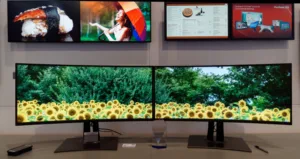Advoli is a company that impressed us at ISE with its HDBaseT supporting graphics cards (HDBaseT Coordinates Supporters). At Infocomm, it was showing the TA4, a four output (at 4K) card that can support genlock and frame lock. It is based on an Nvidia P5000 MXM and also supports cable and temperature diagnostics. The company’s receivers are still reckoned to be the smallest HDBaseT receivers in the world and there are versions that can support 4K over 100 metres (RA1 Performance) or 1080P over 70 metres (RB1 Standard). The receivers can be powered over the HDBaseT connection or by PoE switches.
The company told us that although the receivers have dual fans, they can run on just one, the second being there just for redundancy. The firm has also tested the receivers and knows they can run at 60 deg C, although the fans are needed to stop the surface being too hot to touch.
 Advoli’s HDBaseT are claimed to be the smallest in the world.
Advoli’s HDBaseT are claimed to be the smallest in the world.
The company is also developing a half height PCIe-based HDBaseT extender, the TC1 Extreme, which can support 4K 60fps 4:4:4 video at up to 100m (depending on the cable). It was being shown at the event in a small Shuttle PC, running a small monitor that was also being powered by the cable. The company sees potential applications in the home, where a PC could be in one room, with the display in the living room and very low latency and a single cable. Effectively, the device can be used as a kind of ‘KVM over HDBaseT’. The card will be available in August.
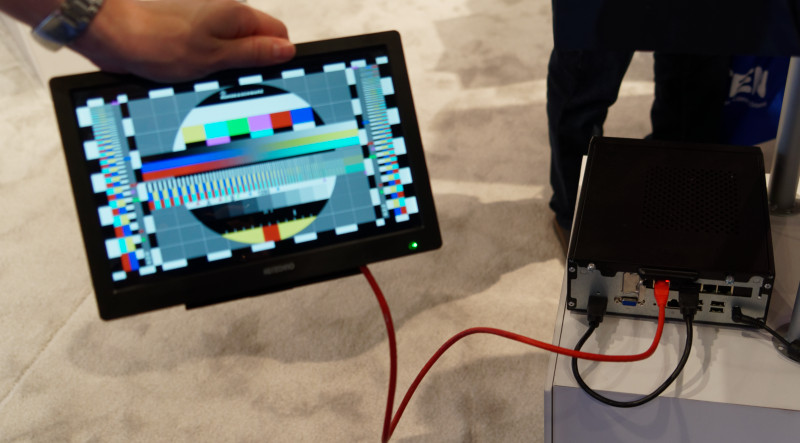 Advoli was driving and powering this remote monitor from its new PCIe card in a Shuttle PC. Image:Meko
Advoli was driving and powering this remote monitor from its new PCIe card in a Shuttle PC. Image:Meko
Atomos highlighted its Sumo 19 recorder monitor which now supports a wide range of HDR technologies. It has been around for a while, but has been updated over time. It can now accept four separate inputs and can show them all and switch one to an input. All the channels can be simultaneously recorded in ProRes as separate files and edited separately.
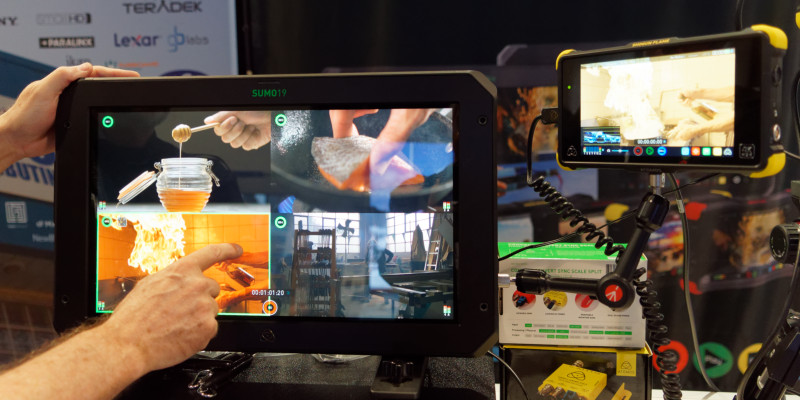 Atomos has updated the Sumo 19 to support four inputs. Image:Meko
Atomos has updated the Sumo 19 to support four inputs. Image:Meko
Brightsign was showing its Series 4 media boxes and was highlighting the support for HDR10+ HDR technology. One of the key applications for the box is in retailers who would like to be able to run HDR10+ compatible demos. We asked if there is also support for HLG but staff didn’t know. They told us that the chip is a Broadcom 7278 but at press time we couldn’t confirm the support.
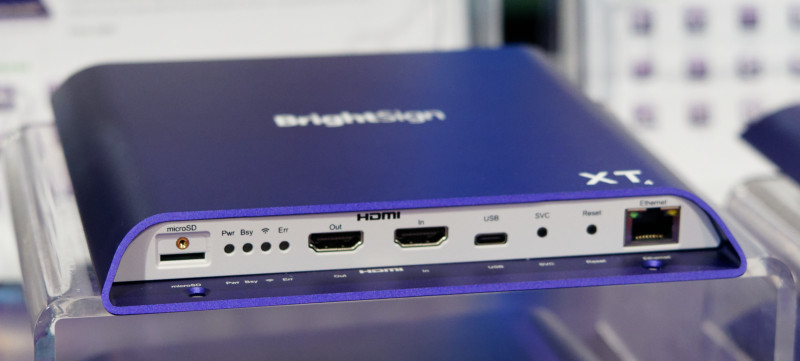 The Brightsign players are being requested by retailers to allow HDR10+ to be demonstrated. Image:Meko
The Brightsign players are being requested by retailers to allow HDR10+ to be demonstrated. Image:Meko
LightMax is a maker of specialised displays in Taiwan and was showing a 43″ curved UltraHD monitor, the DUD4303-A with R1500 and 600 cd/m² of output. It has has a touch screen option and has a wide colour gamut and staff finally (!) admitted that this was achieved using RG phosphor. The company was also showing its ‘re-sized’ displays, which it cuts in house.
LiteMax has also developed support for the Intel SDM (Smart Display Module) in some of its monitors including a 43″ unit and a 55″ as well as a 32″ UltraHD monitor.
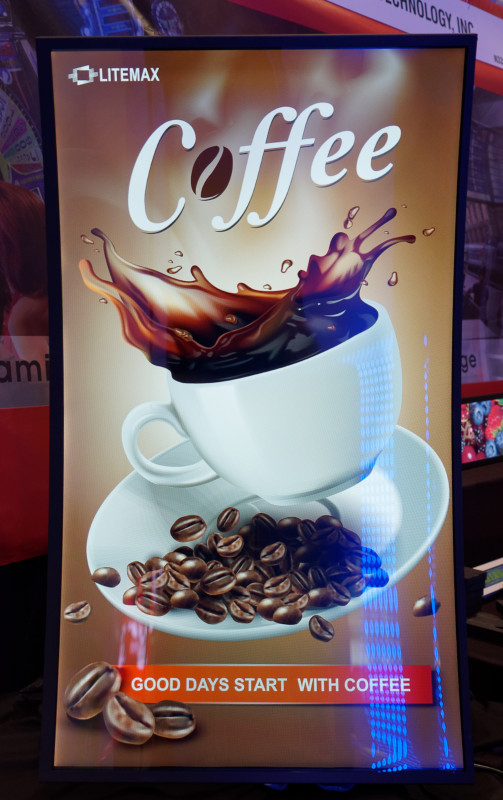 LightMax had a 43″ UltraHD curved display. Image:Meko
LightMax had a 43″ UltraHD curved display. Image:Meko
Philips was very happy that its Android-based digital signage is going well. The company is moving up to Android 7.0.
A new product was a 24″ PCap touch monitor that is fitted with a camera that is a ‘smart device’ that can run Android, or can be used as a traditional monitor, connecting via HDMI. The company also has a 10″ stand-alonet touch display with Android that is seeing use in applications such as room booking.
Staff next pointed us to high brightness 75″ (3,000 cd/m²) and 55″ (2,500 cd/m²) LCDs that the company is now selling in the US.
One of the developments by Philips over the last year or two is the integration of its CMS and cloud-based technology across both its smart signage and hospitality monitor products and to make this easier, the company has developed a QR code-based system to make connections easy. The technology can be used to very quickly deploy apps onto its smart products.
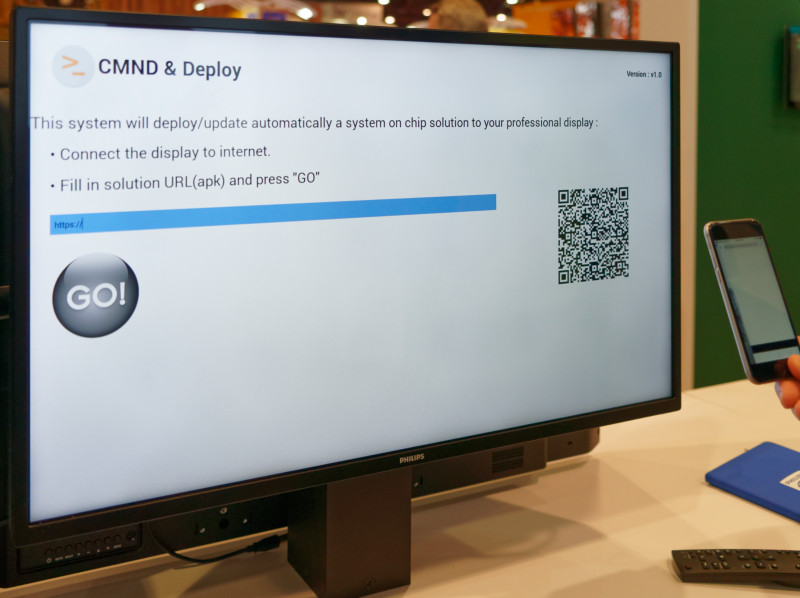 Philips has technology to make app downloads to its smart devices very quick and easy. Image:Meko
Philips has technology to make app downloads to its smart devices very quick and easy. Image:Meko
The company has added 86″ and 98″ UltraHD displays at the top of its ‘D’ range. The Q Line, which runs Android, is still based on FullHD resolutions.
Panasonic was showing its new high end SQ1 86″ and 98″ IPS LCDs at the show for the first time but the ‘entry level’ EQ1 range 43″ to 86″ UltraHD panels were being shown for the first time in the US, having been launched at ISE (Panasonic Shows New Projectors, LCDs at ISE). The SQ1 range includes the (relatively) new Smart Display Module. There is a built-in USB media player and the units are slimmer than 4″ so meet ADA requirements. Another feature is that any of the inputs can be directed to the DisplayPort output and the unit can support PBP and PiP as well as accepting four FullHD inputs.
The company had an interesting set of applications for museums and was very much focused on key verticals, rather than products. The company used a combination of direct view and mapped projection displays to create a ‘museum concept’
Projection products were the same as shown at ISE including a dome mapping lens.
 Panasonic combined mapped and direct displays as they might be used in a museum. Image:Meko
Panasonic combined mapped and direct displays as they might be used in a museum. Image:Meko
Sony did not have any new hardware compared to its ISE products although it was highlighting the VPL-FHZ120 projector that was shown at that event. The company was showing a Userful-based video wall configuration that allows arbitrary display sizes and rotation. We asked what had happened to the Sony Canvas technology, which did the same, but using the processor that was in the PlayStation. However, staff at the show weren’t sure what had happened to that technology.
Of course, Sony was impressing everybody with its CLED display, as usual.
The company also had a 12K (UltraHD displays in a 3 x 2 array) using 10 bit connections via an IP network based on 10G ethernet. The system can be used with video wall displays, but could also be used with a CLED display. It was based on an AVStumpfl Wings Engine server, with ZeeVee Zyper 4K boxes to transmit over SDVoE.
The company was also showing its Bravia Signage software which is available with its smart Bravia signs and staff emphasised that the cost is just $200 per licence.
 This 12K video wall was being shown by Sony. Image:Meko
This 12K video wall was being shown by Sony. Image:Meko
Vestel was at the show for the first time as it looks to develop its B2B business in the US. The company was showing the same hardware as at ISE. It was highlighting that its Android-based infrared touch displays can be operated on the internal SoC and do not need a PC.
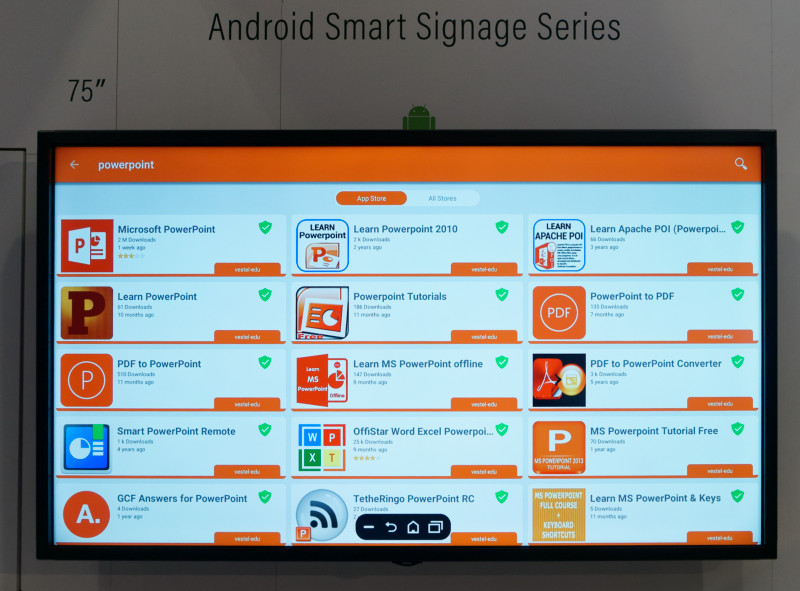 Vestel was highlighting its Android-based signage. Image:Meko
Vestel was highlighting its Android-based signage. Image:Meko
ViewSonic was showing the LS800WU projector that it told us about at CES and we also looked at the PG800HD which was launched last year and which is a 5,000 Ansi lumens FullHD projector that is very good value – it sells in Europe for around €1,100.
The Pro9800WUL was first disclosed last summer but was being highlighted at Infocomm. It has 5.500 lumens of output and has 1920 x 1200 resolution. The projector has been desinged to easily stack. It has a centre lens with vertical and horizontal shift. It costs $2,999
The CDX5562 is a new 55″ FullHD videowall flat panel from the firm that has an image to image bezel width of 1.8mm and can support daisychaining up to 10 x 10 arrays, using DVI and DisplayPort loop through. UltraHD is supported in 2 x 2 configurations.
Output is 700 cd/m² and the unit is fitted with dual 10W speakers. Inputs include HDMI, DisplayPort, DVI, CVBS and component as well as VGA. The monitors have an OPS slot. MSRP is $6,999.
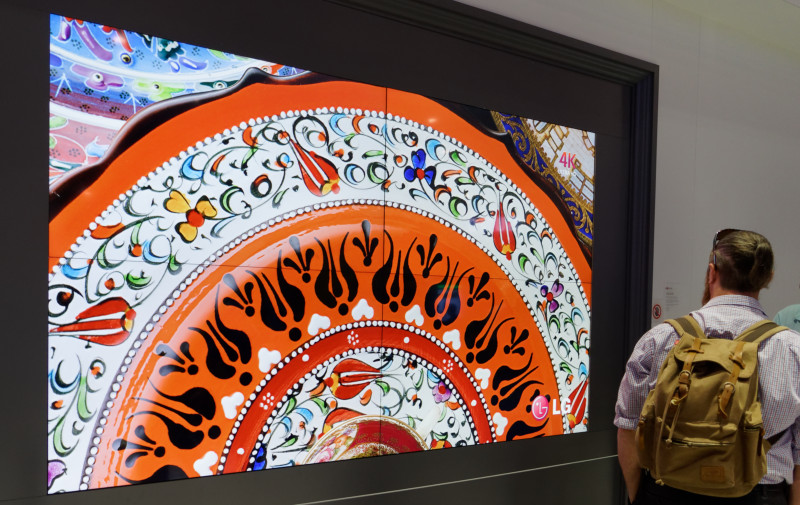 The new ViewSonic 55″ video wall displays have an even image to image distance of 1.8mm. Image:Meko
The new ViewSonic 55″ video wall displays have an even image to image distance of 1.8mm. Image:Meko
The company also highlighted its MyView software and its desktop monitors including the VP3881 38″ curved monitor that was first shown at ISE (although the dual 38″ configuration might, just be overkill!
The dual ViewSonic 38″ curved monitors might, just, be overkill. Image:Meko

